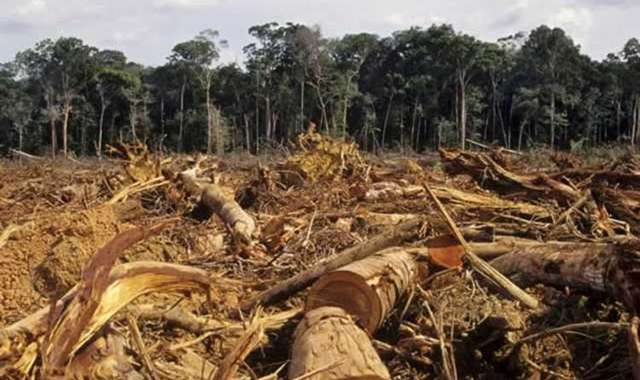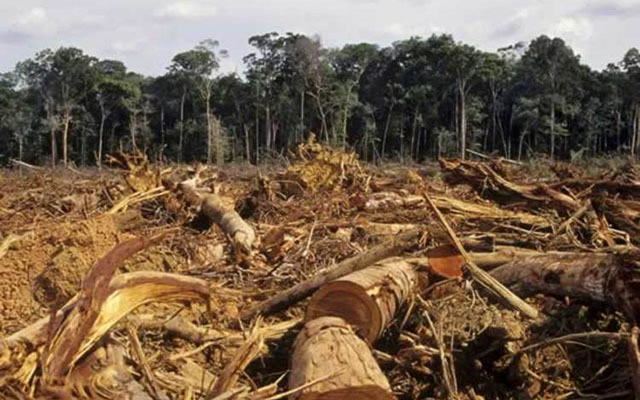Illegal logging threatens Zim forests


Indiscriminate cutting down of trees is rampant in Zimbabwe
Sifelani Tsiko
In the heart of Zimbabwe’s third largest state forest, Mafungabusi in the central part of the country, a soccer pitch has been carved out and a row of shops built with farm bricks, timber and iron sheets showing how an illegal settlement is crossing the line into a permanent feature of a protected zone.
For Kholwani Sibanda, of Zanda Village, an illegal settlement on the banks of Lutope River in the Mafungabusi Forest, the carving of a football pitch offers him and other settlers a haven of hope beyond the heartache of life as a squatter.
He says during weekends and holidays, villagers and other visitors play football on this occupied land – with a patch of rough green turf surrounded by miombo woodland on fragile Kalahari sands.
It offers him and others an opportunity to get off the fields and drown the sorrows of life in a game of football.
“I’m aware that this is a protected forest but Chief Njelele (a chief in Gokwe South) gave us this land,” Sibanda says.
“This is our land now, it’s the land we are using to grow our crops and earn a livelihood. We have our shops, our soccer pitch and our fields to show that we are serious about building a permanent home here.
“It’s our land and Forestry Commission should leave us alone. Zanda is certainly no place for politics and it’s a place where landless people have found new hope to live a decent life.”
Even though Sibanda and other villagers have asserted their rights to the protected forest, constant fear of eviction is a reality they have lived with since they occupied the forest around 2000 when the country embarked on the fast track land reform programme. But the question that still lingers is whether that should be playing out here on a forest of ecological importance, protecting the headwaters for Lutope, Mbumbusi, Sengwa and Ngondoma rivers which feed water into the Zambezi River?
The answer is not easy.
Between shouting encouragement to the players and lamenting their setbacks on the field pitch at Zanda village, deep inside the Mafungabusi Forest, lies the threat of illegal logging of timber, the cultivation of fragile Kalahari soils, siltation of rivers feeding into the Zambezi River and the death of a critical carbon sink.
Even though Sibanda and his community take pride in this settlement which has carved out a 9km stretch into this sensitive and fragile forest, the occupation of protected forests has hit a raw nerve on both sides of the murky line.
“Illegal settlements are threatening the survival of the country’s 14 protected indigenous forests,” says Violet Makoto, a spokesperson for the Forestry Commission.
“There is rapid encroachment into the country’s protected forests and if this continues unchecked, there will be no forest to talk about here in Zimbabwe in the next five years. Our forests, both indigenous and commercial, are under immense pressure.
“What is happening here in Mafungabusi is exactly what is happening in our protected forests in Matabeleland North, Midlands and the Eastern Highlands.”
Lewis Radzire, a district forestry conservator, says the 81 200ha Mafungabusi forest has lost about 15 percent of its area (approximately 12 000ha) to illegal settlements between 1996 and 2015.
“More than 900 households have occupied the area here in Zanda alone not mentioning what is happening in Ngondoma (700 families on 4 000ha), Nyamazana (104 families ) and Sengwa (570 households),” he says.
“The impact of human settlement on protected forests is severe. There is heavy siltation, massive deforestation of delicate indigenous forest, over-grazing and formation of gulleys across the whole area.
“If this persists, in the coming 10 to 20 years there will be no forest to talk about here in Zimbabwe.”
Illegal logging gangs from Gokwe and other towns are also coming into the forest smuggling hundreds of tonnes of trees every month and driving tree species to the brink of local extinction. Mahogany, teak and mukwa trees are major types which are being harvested unsustainably because of their commercial value.
Apart from illegal timber logging, poachers are slipping into forests at night killing wildlife and transferring their natural wealth to highly organised syndicates across the globe.
Indigenous tree species such as munondo and msasa are facing local extinction due to high demand for their wood both for cooking, construction and fencing.
Experts estimate that more than 70 percent of the total volume of wood harvested in the country’s 14 protected forests is unaccounted for, causing huge losses in government revenue from levies, taxes and fees.
Environmentalists complain that fines imposed on those caught are too low to act as a deterrent. They also accuse politicians, chiefs and district forest officials of colluding with illegal loggers who move the wood through unofficial routes.
Zimbabwe has 14 gazetted indigenous forests covering nearly 700 000 hectares.
Forestry experts say these are preserved to promote soil protection, nutrient recycling, biodiversity conservation, climate regulation, wildlife habitats and providing non-timber products, among other benefits. The Forestry Commission has over the years engaged local communities surrounding these gazetted forests to promote participation and conservation of the trees and wildlife.
This has not succeeded to curb illegal logging and poaching of wildlife despite the adoption of joint forest management models with communities neighbouring protected forests, where local communities are allowed to collect thatch grass and other non-timber products from the forests.
“Politicians and chiefs are the major culprits,” says John Sibanda (62) of Mbumbusi village close to the Mafungabusi forest.
“They are getting bribes from people who want land. They are making lots of money and this has affected the programmes we are running with the Forestry Commission. We have a vibrant Resource Management Committee but our work is being stalled by illegal settlers who move into the forestry.
“These people are reckless, they cut trees, kill animals and they even invade and get our share of non-timber products such grass, herbs, honey, amacimbi and broom grass.”
When Mapfungabusi was gazetted as a State forest in 1953, it measured 101 000 hectares, but half of it has been taken over by invaders.
This plays out in all other protected State forests and prime commercial forests in the Eastern Highlands.
There has been a massive reduction in the size of gazetted forests due to illegal land occupations.
Darlington Duwa, chief executive officer of the Timber Producers Federation which represents local plantation companies, estimates that about 20 000 hectares of land has been illegally occupied affecting timber production.
“Most of the timber plantations (in the Eastern Highlands of Manicaland province) are occupied by illegal settlers,” he says. “It’s difficult to know exactly how many settlers have moved onto the area but what we know is that up to 20 000 hectares have been occupied. It is no exaggeration that unless the situation is addressed, the future of the timber industry in Manicaland is bleak.”
Most of Zimbabwe’s exotic timber requirements come from major plantations owned by timber companies that include Allied Timbers Zimbabwe, Border Timbers and Wattle Company. The impact of illegal settlements has been grave.
It has affected local forest management practices, the planting and harvesting process, fire protection plans and worsened the poaching of wildlife.
Timber experts say this has led to loss of revenue and jobs as companies are being forced to lay off people due to timber shortage.
Duwa says the industry lost about 3 000 hectares of planted trees of various ages in 2016 alone. He says this is increasingly becoming a yearly occurrence at a time when in Chimanimani alone, illegal settlers are reported to have destroyed trees on over 5 000 hectares.
Jefferson Matipano, acting director of Zimbabwe National Parks and Wildlife Management Authority Parks (ZimParks), says poaching in protected forests has been rampant and has led to serious losses in the wildlife numbers.
Government has served more than 3 000 illegal settlers in six districts with notices of eviction but these continue to be ignored.
Lack of resources and manpower has crippled operations of ZimParks and the Forestry Commission.
Zimbabwe is losing approximately 330 000 hectares of natural forests and woodlands per year due to the over-reliance on biomass to meet the country’s energy needs.
More than 70 percent of the population depends on biomass for energy needs and this has over the decades depleted the country’s forest cover.
Forest experts say Zimbabwe now has around 15,6 million hectares remaining.
Says Radzire: “The 330 000 hectares loss figure is now outdated and if we carry out a new inventory, it won’t be surprising that Zimbabwe is now losing close 500 000 hectares a year.”
The Forestry Commission says more than 7 000 households have now settled illegally in all the country’s 14 indigenous forests. More than 40 000 people have occupied close to 80 000 hectares about 12 percent of the total area estimated to be close to 700 000 hectares.
“We have lost about 50 percent of our game stock in all the gazetted forests,” says Rodrick Nyahwai, provincial forestry manager for Midlands. “Illegal settlements have made the situation worse. We can’t do proper wildlife management when we have people settling inside the forestry. It’s no longer easy to differentiate a settler from a poacher.”
He says the game stock in Molo Forest and Molecomp Forest in Bubi district have been totally lost while heavy losses have been registered in the bigger forests in Matabeleland North.
Globally, between 50 and 90 percent of wood is harvested or traded illegally, according to United Nations Environment Programme, and it’s estimated to cost $30-100 billion annually.
And, while the football pitch at Zanda village offers occupiers a temporary escape from their emotional land wounds, the environmental headaches that spring from it are terrifying. — Zimpapers Syndication.









Comments